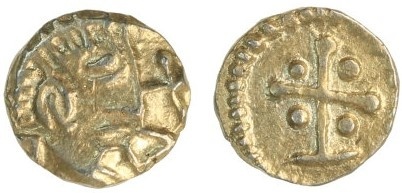
Auction: 23004 - Ancient and British Coins - Featuring the 'White Rose' Collection
Lot: 388
Anglo-Saxon England, Kent, Anonymous Early Christian Issues, temp. Eorcenberht (c. 620-655), Crondall Phase, Pale Gold Shilling, "LEMC" Type, diademed head right, with disconnected tie behind, longer cross pommeé before, rev. long cross pommeé (crucifix) on flat ground-line, pellet in each quarter, 1.27g [19.6grns], 12h, 9.64mm ("Peckham Hoard, no. 4" = BM 2021T48 = PAS: KENT-687A04 this coin; cf. Prou 2724), pleasingly centred on a small but chunky flan, an endearing and proud portrait, good very fine, UNIQUE, and a significant addition to the Early Anglo-Saxon English gold coin corpus
Provenance
Recovered from a scatter of five gold coins and two lead weights, at Peckham (Kent), 2021
~ Recorded with the British Museum [ref. BM 2021T48 =PAS KENT-687A04], declared treasure at inquest, but partially disclaimed ~
Dr Tony Abramson, comments on this coin (January 2023): "This unique coin was initially described as a Merovingian tremissis on the Portable Antiquities Scheme’s database. However, there were lingering suspicions that it could be part of the Anglo-Saxon corpus of gold shillings, due to the similarity of the portrait to a group of coins in the Crondall hoard, at the Ashmolean Museum, Oxford, referred to as “LEMC” types due to their common inscription. (GCASE 310-320). However, the portrait on this coin is right facing, whereas the LEMC busts are all left facing. By the simple expedient of mirroring the obverse portrait of this unique Peckham coin for comparison with the LEMC specimens, the stylistic similarities are undeniable. Therefore, the Peckham coin can now confidently be placed in the Anglo-Saxon corpus.
It is exceedingly rare for securely-pedigreed coins from Anglo-Saxon gold hoards to ever appear legitimately on the open market; particularly those that have been so exhaustively studied by the finest academic minds of today. The iconographic similarities of this new coin to the well-known Witmen and Wuneetton varieties struck during the reign of Eorcenberht, King of Kent (c. 640-665) are plain. The prototype inscribed-coinage of his predecessor Eadbald (c. 616-640) can also be seen stylistically in the rendering of the cross pommeé crucifix on the reverse of this new find. The potency of this symbolism within a Kingdom that had only converted to Christianity in AD 619, is stark, both in the imitative classical style of art practiced in the period, but equally in the economic development of the post-Roman Britain in one of the oldest Kingdoms of the fledgling Heptarchy.
Subject to 20% VAT on Buyer’s Premium. For more information please view Terms and Conditions for Buyers.
Sold for
£10,000
Starting price
£10000




